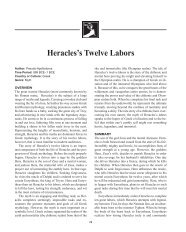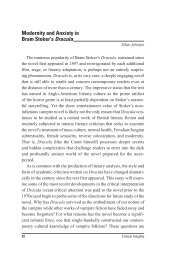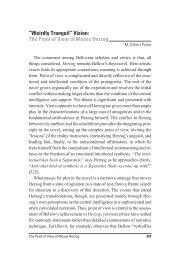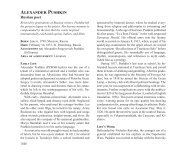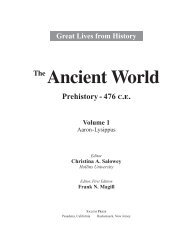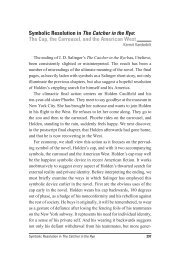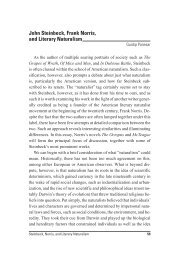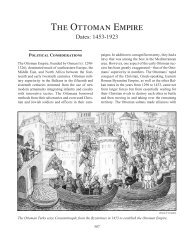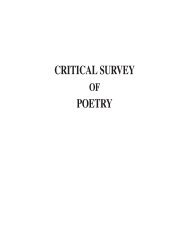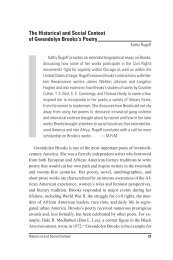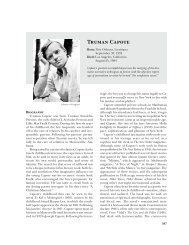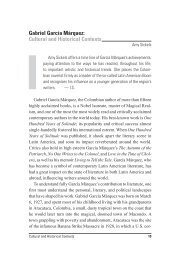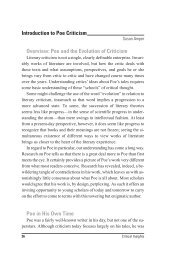“A Fragment of Lost Words”: Narrative Ellipses in The ... - Salem Press
“A Fragment of Lost Words”: Narrative Ellipses in The ... - Salem Press
“A Fragment of Lost Words”: Narrative Ellipses in The ... - Salem Press
Create successful ePaper yourself
Turn your PDF publications into a flip-book with our unique Google optimized e-Paper software.
pr<strong>in</strong>cipal characters. He makes a last visit to Gatsby’s mansion. And he<br />
tries one last time to draw some conclusions from Gatsby’s story:<br />
Gatsby believed <strong>in</strong> the green light, the orgastic future that year by year<br />
recedes from us. It eluded us then, but that’s no matter—to-morrow we will<br />
run faster, stretch out our arms farther ...Andonef<strong>in</strong>e morn<strong>in</strong>g—<br />
So we beat on, boats aga<strong>in</strong>st the current, borne back ceaselessly <strong>in</strong>to the<br />
past. (180)<br />
Here Nick uses first a long dash and then a set <strong>of</strong> ellipses to suggest a<br />
break<strong>in</strong>g away from the present and a reach<strong>in</strong>g out toward a promised,<br />
idealized future. Note the shift from “Gatsby” <strong>in</strong> the first l<strong>in</strong>e to the<br />
first-person plural “us” and “we” <strong>in</strong> the second. Nick, his protagonist,<br />
and the reader are folded together <strong>in</strong>to a confederacy. <strong>The</strong> trail<strong>in</strong>g ellipses<br />
after “stretch out our arms farther” are falter<strong>in</strong>gly optimistic, the<br />
trail<strong>in</strong>g <strong>of</strong>f <strong>in</strong> midsentence <strong>of</strong> someone who sees a vision on the horizon.<br />
“One f<strong>in</strong>e morn<strong>in</strong>g” marks the beg<strong>in</strong>n<strong>in</strong>g <strong>of</strong> the vision itself: the<br />
imag<strong>in</strong>ed day on which the much-anticipated, orgastic future comes<br />
<strong>in</strong>to be<strong>in</strong>g. But then a long dash follows, end<strong>in</strong>g this reverie and dash<strong>in</strong>g<br />
the dreamer’s vision by br<strong>in</strong>g<strong>in</strong>g him back not only to the present,<br />
but to a present <strong>in</strong>formed by and drawn back <strong>in</strong>to the past. <strong>The</strong> novel<br />
therefore concludes with Nick caught between an elusive future and an<br />
irredeemable past, his narrative voice hover<strong>in</strong>g somewhere between<br />
Gatsby and himself, between then and now, between speech and silence.<br />
Works Cited<br />
Abbot, H. Porter. 2002. <strong>The</strong> Cambridge Introduction to <strong>Narrative</strong>. Cambridge:<br />
Cambridge University <strong>Press</strong>.<br />
Booth, Wayne. 1967. <strong>The</strong> Rhetoric <strong>of</strong> Fiction. Chicago: University <strong>of</strong> Chicago <strong>Press</strong>.<br />
Baxter, Charles. 2007. <strong>The</strong> Art <strong>of</strong> Subtext. St. Paul, M<strong>in</strong>n.: Graywolf <strong>Press</strong>.<br />
Eliot, T. S. 1962. <strong>The</strong> Complete Poems and Plays: 1909–1950. New York: Harcourt,<br />
Brace & World.<br />
<strong>“A</strong> <strong>Fragment</strong> <strong>of</strong> <strong>Lost</strong> <strong>Words”</strong> 203



